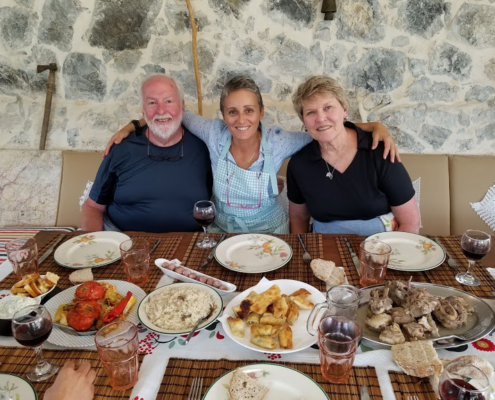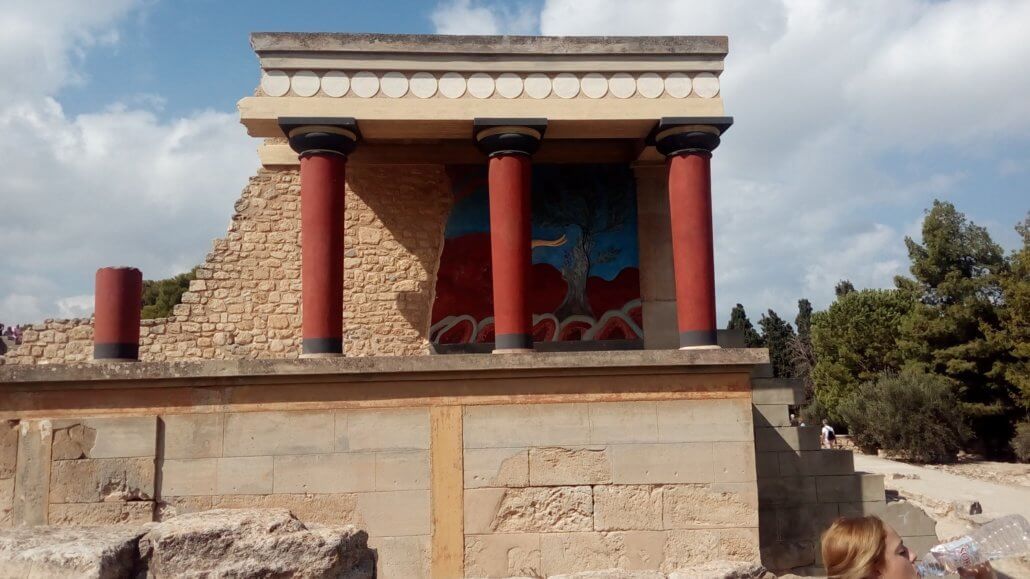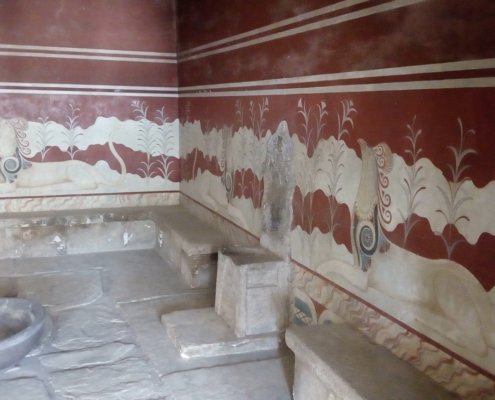Crete’s Five-Star Cretan Hospitality on our Volunteer Vacation
In Part Two of their blog post about their service program in Crete, Greece Volunteers Tom and Rondi Olson talk about Cretan history, hospitality, cuisine and free-time activities available to volunteers serving in Greece! Read Part One.
Discovering Crete’s “Backstory.”
We came to Crete without a mental picture, and really had no idea what to anticipate. We learned that Crete is the largest of over 3,000 Greek Islands, oval in shape, that runs East-West (a 4-hour drive) and North-South (a 1.5-hour drive). In the center of the Island, cutting the island across East to West, is the largest mountain range in Crete. The “Lefki Ori,” or “white mountains” are the highest point of Crete at an altitude of 8,057 feet. Most of our travels were along the Northwest coast, experiencing its jaw-dropping beauty, and a little into the mountains of that quadrant.
The history of Crete dates back over 80,00 years – one of the earliest civilizations ever recorded. At the Archeological Museum of Heraklion, we saw artifacts dating back over 8000 years. The civilization then, known as the Minoan civilization was destroyed – twice – by an earthquake and tsunami, resulting in the Minoans’ having to rebuild each time from scratch. We visited the ruins of Minoa, the Palace of Knossos, dating back to 6000 BC. Except for the setting, it reminded me of Machu Picchu. Archaeologists have done an amazing job in restoring fragments of artifacts like pottery, frescoes and crafts to assemble a replica of the Palaces original beauty. This was, after all, the center of the Minoan Empire.
Because of Crete’s location, central in the Adriatic Sea, it has been the target of virtually every surrounding civilization. The island was once held by the Turks and Romans in two Byzantine eras, the Venetians, and even the Germans during World War II. The society fought for and gained their independence in the late 1800s, and did not become part of Greece until the early 20th century.

Cretan People and Hospitality
Global Volunteers stays in the beach town of Amoudara, a convenient 20-minute bus ride just outside the capital, Heraklion. Here you can find a number of spectacular museums, upscale restaurants, and cafes all offering that special Cretan hospitality. Our experience is the Cretan people are universally friendly, helpful, and extremely generous. Stop for a cup of coffee, (be it in a mountain village or a coastal town) and you’ll be greeted with a smile and friendly hello. “Kali Mera” you’ll get cookies, peanuts, water and raki (island brew) with your coffee all for 1.5 Euros. Enjoy a meal, dessert arrives compliments of the house. The same applies to the winery – buy a couple of bottles, and they throw one in free. Very warm and generous people.
They also are extremely industrious. Many have day jobs, but also work-family olive orchards, industrially sized bee colonies, huge produce/ flower gardens and the like. Some are passed down in the family for generations. So unlike our urbanization where the young left their family farms and went to the city, here in Crete, they have come to the city, but maintain their ties to their rural roots.
Cretan food

Typical of other island civilizations, Crete has had to adapt to live on what is on the island. Fortunately for them, there is an abundance of terrific foods. Olive trees litter the landscape. Driving across the country, olive trees are as prevalent as all species of trees are in America.
The island has ideal conditions for a wide variety of fruits and vegetables – many only found on Crete. The prototypical menu item is the Greek (Cretan) Salad. Tomatoes, cucumbers, onions, olives, croutons, green pepper, sometimes potato, eggs, lightly dressed and topped with a square of feta cheese with olive oil, oregano, and pepper.
“Crete in a bowl.”

Common entree items include squid, octopus, and all sorts of local fish. Land animals include goat, lamb, chicken, and even snails. Yogurt, which is omnipresent, is made from goat’s milk. Cooking uses olive oil where we would use butter.
Farm-to -table is not a “thing,” it’s a way of life. One of our excursions was into the mountains to a cooking school run by a very industrious and hospitable woman, Vaggelio. She lives in the village of Vamos having turned the grounds of her home into a combination of petting zoo and garden of paradise. She had ducks, dogs, and birds. She raised bees, vegetables, olive trees, flowers, herbs, fruits, and who knows what else.
Tom and Rondi at their cookery class. Crete, Greece.
We also visited the Paraschakis family three women, expats. A mother and two daughters who came to Greece over twenty years ago when the daughters were very young, and none of them have been back to the U.S. since. One daughter with her husband grows olives for oil and together, they are the regional olive oil refiner. The other daughter and her husband grow table olives, raise bees, make cheese – and the husband is also a butcher. The mother, by her choice, lives alone in a nearby village, gut spends her day flitting around the family’s businesses up in the mountains’ wine-producing area.
We stopped at a very prosperous wine producer, who has worked to revive native Cretan grapes with other species we would be familiar with Cabernet, Merlot, etc. Besides a brief tour, we had an extensive tasting of six of their wines – most were very good. We also enjoyed their olives, honey, yogurt, and wine. The Cretan diet. Simply delicious!!!
Global Volunteers enables people of all ages to fulfill their volunteer goals through worldwide programs. Learn more about how you can make a difference in Greece. Or Chat Online with a Volunteer Coordinator to get started today!












Leave a Reply
Want to join the discussion?Feel free to contribute!